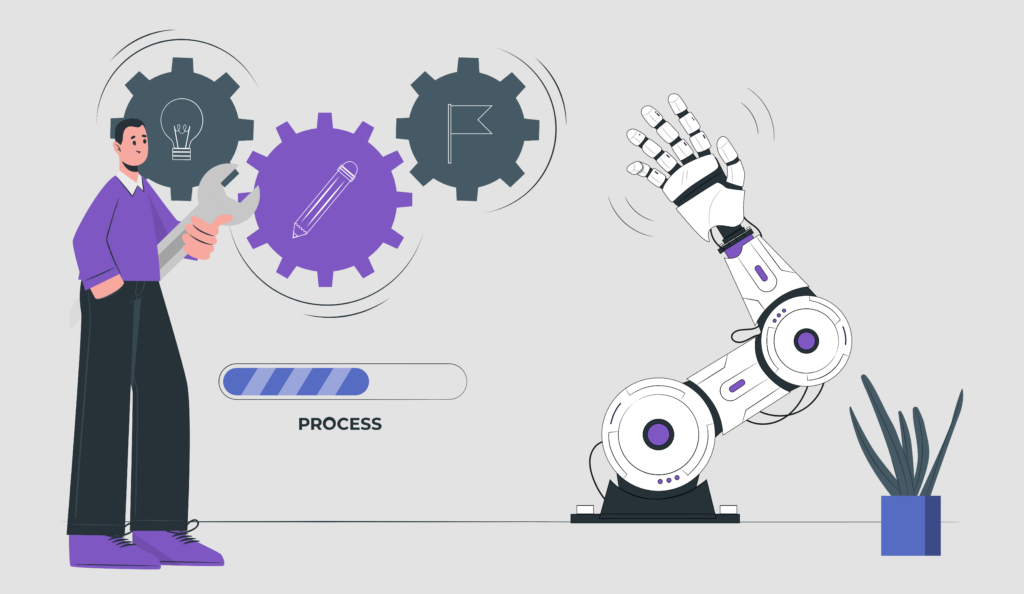Table Of Content
- What is Business Process Management (BPM)?
- Understanding Workflows and Workflow Automation
- Developing a Business Process Management Strategy
- The Role of the Management Team
- Business Process Management Software (BPMS)
- Robotic Process Automation (RPA) Capabilities
- Task Mining and Process Mining
- The Next Evolution: Converging AI with Business Process Management
- A Core Use Case for Back Office Intelligent Automation
- Microsoft Power Automate: A Comprehensive Automation Solution
In today’s fast-moving digital economy, competitive pressure and rapid market changes are forcing organizations to operate with maximum efficiency. The key to achieving this lies in a disciplined approach to streamlining and optimizing the internal processes that drive the business.
The foundation of any successful digital transformation strategy is the optimization of the core business processes that drive operational performance.
This blog explores the foundational discipline of Business Process Management (BPM). We will break down how understanding and automating your core workflows can reduce costs, enhance productivity, and empower your teams to focus on the strategic work that truly drives growth.
What is Business Process Management (BPM)?
Business Process Management (BPM) focuses on analyzing, optimizing, and streamlining an organization’s processes to enhance efficiency, productivity, and adaptability. By integrating process analysis with potential automation, BPM creates a framework where tasks can be executed more consistently, reducing errors and delays while enabling employees to concentrate on higher-value activities.
BPM oversees the end-to-end process of synchronizing people, systems, and information to achieve strategic outcomes. This holistic approach ensures that organizations can continuously refine their processes, making BPM a dynamic and ongoing effort to improve operations and adapt to evolving business needs.
Types of Business Processes
BPM encompasses three primary categories of business processes within an organization:
- Operational Processes: Core tasks directly tied to the primary business activities, such as handling customer orders, managing manufacturing operations, and processing transactions.
- Management Processes: Tasks focused on overseeing and controlling various aspects of the business, including corporate governance, budgeting, and strategic management activities (e.g., corporate strategy, compliance, or performance monitoring).
- Supporting Processes: Tasks that support operational and management processes, covering areas such as accounting, recruitment, and technical support.
You can also classify process automation by how they are applied based on the nature of the tasks, interactions, or dependencies within those processes.
- Human-centric: Focuses on processes that require significant human involvement, such as approvals, decision-making, and collaboration.
- Document-centric: Involves processes that revolve around document handling, like creating, reviewing, and approving contracts.
- Integration-centric: Deals with processes primarily involving system-to-system interactions, such as automated data synchronization between enterprise applications (e.g., CRM and ERP systems), with minimal human involvement, with minimal human involvement.
Understanding Workflows and Workflow Automation
A workflow represents a detailed sequence of tasks or steps within a specific part of a business process, outlining how tasks should be completed, who is responsible, and in what order. Workflow automation uses software tools to streamline these workflows, particularly repetitive, manual tasks, by executing predefined rules, conditions, or event-based triggers.
Automating workflows eliminates bottlenecks, accelerates task completion, ensures consistency through standard procedures, reduces labor costs, and minimizes human errors. By implementing workflow automation, businesses achieve greater efficiency and improve their operations.
Developing a Business Process Management Strategy
A successful BPM strategy involves understanding existing processes and identifying inefficiencies, redundancies, or bottlenecks that slow productivity or increase costs. One of the foundational steps in this strategy is process mapping, which involves visually representing workflows to understand how tasks are performed and how they interconnect. This mapping helps identify areas that need improvement and serves as a guide for optimizing and streamlining processes.
The BPM lifecycle follows five essential stages: Design, Model, Execute, Monitor, and Optimize. During the Design phase, organizations work with stakeholders to review current processes and identify weaknesses. The Model stage involves defining and presenting the redesigned process and specifying timelines, tasks, and data flows. Next is the Execute stage, where the newly designed process is implemented and tested. The Monitor stage focuses on tracking the process’s performance using predefined metrics, and finally, the Optimize stage involves making adjustments to improve efficiency and effectiveness based on monitoring results.
Incorporating process mapping is a collaborative effort. It allows key business stakeholders—the employees who execute the processes every day—to work alongside technical experts. This partnership ensures that the real-world pain points and opportunities for automation are identified with precision and accuracy.
Organizations can enhance process optimization and automation efforts by engaging a broader range of employees. This inclusive approach ensures that automation is more widespread, allowing employees from various departments to contribute to refining and improving business processes.
The Role of the Management Team
The management team plays a crucial role in BPM by ensuring that automation initiatives align with the organization’s goals and digital transformation objectives. They oversee resource allocation, facilitate smooth change management, and provide strategic guidance throughout implementation.
For effective BPM, management teams need to engage with employees who bring diverse perspectives and skills—from those who identify areas for improvement to those who provide technical support and execute projects.
This collaborative approach ensures that processes are thoroughly analyzed and mapped out, often using tools like flowcharts or process-mining software to understand existing workflows and identify areas for enhancement.
The team also plays a pivotal role in redesigning processes by incorporating feedback from stakeholders, ensuring that the proposed changes are practical and effective. Furthermore, they encourage adopting and refining BPM practices across the organization, ensuring that the implemented processes are continuously monitored, optimized, and aligned with evolving business needs.
Business Process Management Software (BPMS)
Incorporating Business Process Management Software (BPMS) is essential for automating repetitive and manual tasks, which enhances efficiency, accuracy, and productivity. BPMS tools connect seamlessly with existing systems, applications, and workflows, enabling organizations to automate data entry, approvals, notifications, and report generation without extensive human intervention.
Modern BPMS solutions are designed to be more accessible, often incorporating low-code interfaces with drag-and-drop features to accelerate development. While these tools empower a broader range of users to build and test workflows, they also provide the robust, enterprise-grade capabilities that skilled developers need to tackle more complex integrations. These platforms often come with pre-built templates and connectors that can be customized to ensure the automation functions as intended before full deployment.
Many BPMS solutions are cloud-based, offering significant advantages over traditional on-premises tools. Cloud-based automation provides greater scalability, allowing businesses to adapt to changing demands without worrying about infrastructure limitations. It also ensures security features managed by the provider (e.g., encryption, identity management, compliance frameworks). It offers flexibility by enabling employees to access and manage workflows from anywhere, making it ideal for organizations with remote or distributed teams.
Robotic Process Automation (RPA) Capabilities
Robotic Process Automation (RPA) is a technology that uses software “robots” to handle repetitive, rule-based tasks across digital systems. These bots can perform activities like data entry, processing transactions, generating reports, and responding to emails, mimicking human actions with precision and speed.
RPA complements BPMS by handling specific repetitive tasks within larger business processes. While BPMS focuses on managing end-to-end processes, RPA performs granular tasks, making workflows more efficient. The combination of RPA and BPMS provides a comprehensive automation solution, enabling organizations to achieve higher productivity, accuracy, and cost savings.
Task Mining and Process Mining
Task mining focuses on capturing, analyzing, and understanding how employees perform individual tasks on their computers. It collects data from user interactions, such as mouse clicks and keyboard inputs, to identify patterns, repetitive actions, and inefficiencies. Task mining helps pinpoint areas suitable for automation, particularly repetitive tasks that can benefit from RPA.
Process mining, on the other hand, provides a broader view by analyzing event logs from IT systems to visualize, understand, and optimize entire business processes. It reconstructs workflows by examining the sequence of events across systems like ERP or CRM applications, helping organizations identify bottlenecks, deviations, and areas for optimization.
Together, task and process mining offer valuable insights that drive automation and process improvements at both granular and macro levels.
The Next Evolution: Converging AI with Business Process Management
For over a decade, the primary goal of automation has been to improve efficiency by tackling the structured and predictable parts of a business. This has been incredibly powerful for automating high-volume, repetitive tasks that follow a clear set of rules.
However, a significant portion of back-office work does not fit this description. It is messy, unpredictable, and requires human judgment. It is locked away in unstructured documents, emails, and complex, exception-filled workflows. Historically, this has represented the traditional boundary of automation—the point at which rule-based tools could go no further.
This is where Artificial Intelligence (AI) fundamentally changes the landscape.
AI is not just another tool; it is a new intelligence layer that can help handle previously unpredictable, judgment-based work that has always required a human. The goal is no longer just to automate simple tasks, but to augment your entire operation with intelligence.
How AI Transforms Traditional Business Processes:
- It Understands Unstructured Data: Where older automation required a fixed template, modern AI can read and interpret unstructured content like a human. It can understand the intent of an email, extract specific data from any invoice format, and analyze the clauses in a legal contract. This unlocks the majority of enterprise data that was previously “dark” to automation.
- It Handles Nuance and Makes Judgments: Where traditional Business Process Management (BPM) required a rigid, pre-defined set of rules, AI can now make nuanced, context-based decisions. It can flag a financial transaction for potential fraud or determine the sentiment of a customer complaint.
- It Manages Complexity and Adapts to Exceptions: AI-powered systems, often called “agentic AI”, can orchestrate entire, complex workflows. When they encounter an exception that a simple software ‘bot’ is not equipped to handle, they can reason about the problem, adapt their approach, or intelligently route the issue to the right human expert.
By layering this new intelligence into your business processes, organizations can now move beyond automating simple, repetitive tasks. They can begin to automate the complex, judgment-based business functions that lie at the very heart of their operations, creating a truly resilient, efficient, and intelligent enterprise. Understanding how to leverage this new capability to build a lasting competitive advantage is the core of a modern digital strategy.
A Core Use Case for Back Office Intelligent Automation
As we’ve discussed, business processes can be categorized as operational, management, and supporting. While the principles of managing business processes can be applied across an entire organization, perhaps the most significant and immediate opportunity for impact lies within the supporting and operational processes that make up an organization’s back office.
Functions like finance, accounting, and HR are often characterized by high-volume, repetitive tasks and a heavy reliance on unstructured data. This combination of factors has historically made them a major source of operational friction and cost, but it now makes them the ideal proving ground for the intelligent automation capabilities we’ve introduced.
Applying these principles to transform the operational core of a business is a major strategic initiative. To provide a comprehensive guide for leaders exploring this opportunity, we have published an in-depth blog focused on intelligent automation.
Microsoft Power Automate: A Comprehensive Automation Solution
Microsoft Power Automate is a cloud-based automation platform that enables businesses to streamline repetitive tasks and workflows, improving efficiency and productivity across various departments. It offers a low-code/no-code interface, allowing users to create automated workflows that connect different apps and services easily.
With its drag-and-drop functionality and pre-built templates, Power Automate simplifies system integration and automates tasks like data entry, notifications, approvals, and more. In addition to workflow automation, Power Automate offers advanced capabilities such as RPA, allowing organizations to handle tasks involving legacy systems or applications that lack APIs.
Power Automate’s Process Advisor provides task mining and process mining capabilities, helping businesses gain insights into task execution and identify opportunities for automation. It integrates seamlessly with Microsoft products like Office 365, Dynamics 365, Teams, and third-party applications, enabling end-to-end automation solutions.
By leveraging AI and process insights, Power Automate empowers businesses to optimize processes, make data-driven decisions, and enhance overall operational efficiency. For the most complex, mission-critical challenges that require a bespoke solution, these platforms serve as an excellent foundation for more advanced, custom-developed AI integrations.









I’m really intrigued by the concept of BPMS tools connecting seamlessly with existing systems – can you elaborate on how this integration process typically occurs? Are there any best practices for implementing business process automation in conjunction with BPM software to maximize efficiency and minimize disruptions to core operations?
I’m so excited about BPMS tools integrating with existing systems! They can be integrated via APIs or pre-built connectors, which simplifies the process of implementing business process automation and management. This streamlined approach ensures seamless communication between various software applications and workflows, allowing for more efficient automation and data exchange. By adopting a holistic BPM strategy, organizations can optimize their processes, enhance productivity, and reduce disruptions to core operations. Business process management is all about analyzing, optimizing, and streamlining processes, while business process automation focuses on executing tasks consistently, minimizing errors, and freeing up employees to focus on strategic activities.
Hi! 🙏 I completely agree that seamless integration between BPMS tools and existing systems is crucial for successful business process automation. To achieve this, it’s essential to follow a structured approach, such as the BPM lifecycle stages (Design, Model, Execute, Monitor, and Optimize). Engaging with employees from various departments can help identify areas for improvement and ensure that automation efforts are aligned with organizational goals. By adopting low-code/no-code interfaces and leveraging pre-built templates and connectors, organizations can streamline their workflows and enhance productivity. Thanks for highlighting the importance of integration in business process management! 👏
Integrating BPMS tools involves connecting existing systems through APIs, SDKs, or pre-built connectors to ensure seamless automation for effective business process management.
Best practices for implementing business process automation include thorough process mapping, stakeholder engagement, and regular monitoring to optimize workflows and minimize disruptions.
I’d argue that seamless integration is achieved through APIs, connectors, or pre-built templates provided by BPMS tools. Best practices for implementing business process automation involve identifying pain points, conducting thorough analysis, and engaging stakeholders throughout the BPM lifecycle, including Design, Model, Execute, Monitor, and Optimize stages. Effective implementation requires a holistic approach to optimize workflows and adapt to evolving business needs.
Honestly, I’m not too familiar with the integration process of BPMS tools with existing systems, but from what I gathered in the article, it seems like most modern solutions offer pre-built templates and connectors to make things easier. For business process automation, it’s all about designing workflows that connect with current systems without requiring extensive coding skills. The article mentions cloud-based solutions provide scalability and security, which is a plus. Just not sure what else to say…
Meh, I guess it’s pretty straightforward. Most BPMS tools use APIs or pre-built connectors to integrate with existing systems. Some may require custom development, but many have low-code interfaces that make it easier for non-technical users to build workflows. Business process management is all about streamlining processes and automating tasks, so just start by analyzing your current workflow and identifying areas for improvement.
What’s the deal w/ all this fuss ’bout low-code/no-code interfaces? Don’t they just enable business process automation w/o any real substance?
I’ve been there too! During my time at NovaTech, we implemented business process automation using low-code tools, which reduced manual errors by 80% and freed up our team to focus on innovation. It’s a game-changer for digital transformation – trust me, it’s worth the investment!
I’d love to hear more about the BPMS solutions you’ve highlighted – could you elaborate on how these tools can be integrated into existing systems, particularly in terms of data governance and business process management?
I appreciate your insights on BPM & automation! Business process automation is key to efficiency.
Great post! Love how you’ve distilled business process management into its core categories. Your example on human-centric processes is spot on 💡.
Hii!! 🙋♀️ just finished reading this blog post on BPM lifecycle stages 😴 I’m loving how they emphasize the importance of involving citizen developers in process mapping 👥 it’s def a game changer for biz process automation! 🤖 do u think orgs are leveraging low-code tools effectively to improve business process automation efforts? 💬